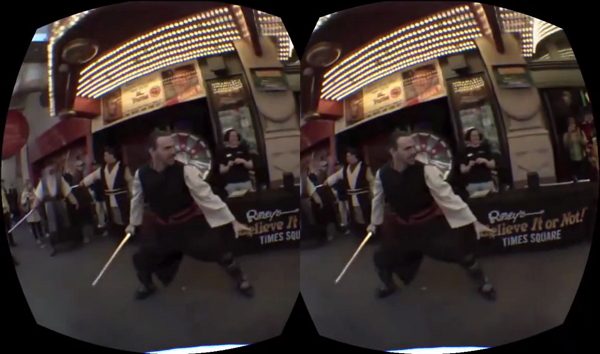Total Cinema 360 is a company that specializes in recording 360 degree video. They’re now formatting their footage for the Oculus Rift head mounted display and enabling head tracking to let users look around the live action scene.
Total Cinema 360 uses a camera rig with six 12MP lenses to capture approximately 80% of a sphere. The footaged is stitched together into a virtual sphere. Such video capture is nothing new — in fact, it’s been around for several years. However, viewing it wasn’t particularly immersive as the usual way of doing it is to drag your mouse around to spin the scene (lacking not only head-tracking, but a wider than normal field of view), like this scene.
Total Cinema 360 is taking their spherical footage and adapting it for playback on the Oculus Rift. Because nearly the entire scene is already being captured (unlike a traditional camera with a fixed field of view) adding the peripheral vision to account for the Rift’s wide field of view is just a matter of formatting the video in the right way. Head tracking from the Oculus Rift is enabled and offers an intuitive way to explore the scene around the user.
The company has launched a Mac version of its Total Cinema 360 Oculus Player, with sample footage, which you can download here. A Windows version will be available on the 15th of October.
With 360 degree video, viewers can be placed right in the center of the action. As in the test footage shown above, filmographers could use 360 degree recording to put the viewer right in the middle of a heated conversation — leaving it up to the viewer to decide who or what to focus on while in the scene. Sports and other events that “you have to be there” for could also be convincingly represented in virtual reality.
Unfortunately absent from the Total Cinema 360 Oculus Player is stereoscopic 3D. One can imagine the challenge of capturing 360 degrees in 3D — all 3D capture is done with two cameras placed near each other to capture slightly different views of a scene (just like our eyes). If you want to capture in 360 degrees, however, the other camera will naturally be occluding most of the scene.
That’s not to say it’s impossible, however. Making View, another company that shoots 360 degree video and launched its own Oculus Rift player, says that they’ve been experimenting with techniques that would allow for 3D recording in 360 degrees:
“Our current cameras used in production do not shoot stereoscopic 360 degree content, but after creating the VR viewer we saw the use for this, and have therefore begun experimenting with a new camera rig to explore and try to solve the challenges this presents,” Making View Chief Software Engineer Daniel Ervik told 3D Focus.
We’ve reached out to Making View to see how their experiments are coming along.







